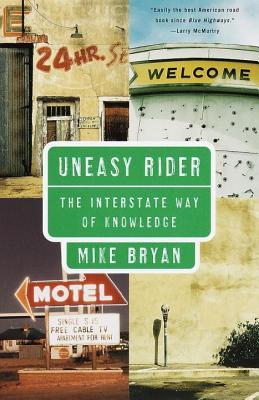The interstate highways, John Steinbeck complained in his 1962 memoir Travels with Charley, “are wonderful for moving goods but not for inspection of a countryside. When we get these thruways across the country, as we will and must, it will be possible to drive from New York to California without seeing a single thing.” When Steinbeck wrote these words, the interstate-highway system was still but a planner’s dream, the brainchild of the Eisenhower administration intent on creating a system whereby military units could quickly move from one homefront theater to another. Thirty-five years later, that system of national roads now completed, Mike Bryan insists that Steinbeck got it wrong. There is much to see beyond their shoulders, he argues. And finds much to report.
In Uneasy Rider—a genial book whose title is a bad pun, certainly not revealing of the author’s tone—that insistence occasionally peaks at downright annoyance. Bryan argues strenuously against the notion that the big highways “create and convey a homogenous culture, suburban and absolutely Middle American.” He takes potshots at writers like William Least Heat Moon, whose Blue Highways is the leading modern exemplar of the road-less-traveled genre, airily dismissing their search for arcane, rare, and forgotten pockets of America that “don’t have even marginal currency in the culture at large.” For Bryan, the interstate is where the real America is to be located, no matter what a host of other travelers have to say about the matter.
And so, studiously ignoring the ubiquitous Stuckeys and Burger Kings that make one stretch of interstate so much like the next, Bryan takes to the highway: in his case, mostly I-20 and I-1O, and mostly in Texas. It is an enjoyable ride, so much so that we are inclined to forgive his previous bad temper, and it takes in some fine detours along the way. His stops include a too-brief visit with the reclusive novelist Cormac McCarthy in El Paso; a longer sojourn at the sludge treatment facility in nearby Sierra Blanca, where New York City’s waste meets the West Texas desert; and overnight stays in little towns into which the interstate feeds only thanks to political machinations that spared their being passed by. His pages are full of well-wrought history, for nearly every interstate follows paths laid out long before: sometimes by Native American hunters, sometimes by pioneer wagon trains, sometimes by mere accidents of topography. Bryan also ferrets out the bizarre and unfamiliar at roadside stops; among the best instances is a call on “a rattlesnake rancher with twenty-first century ambitions,” a dabbler in all things entrepreneurial who aims to expand his Texas empire to include turtles, emus, and hedgehogs.
In Bryan’s book, there is no short way from Point A to Point B. The charmingly topsy-turvy organization finds Bryan in Dallas one moment, in Flagstaff the next, and in Truth or Consequences after that. The scheme conveys something of the frantic speed of the roadway, and it is a little dizzying at times. Many of his venues are the result of creative fudging: he is fond, for instance, of Laughlin, Nevada, the blue-collar Las Vegas, which lies 20-odd miles from the nearest interstate and does not figure on many maps, although it is now Nevada’s second- favorite gambling destination. (Another cheat: the book’s cover sports a view from Arizona’s Tucson-Nogales Highway, far more picturesque than the interstate.)
You will learn from Bryan that the state of Texas is 878 miles wide along I-10, that Lone Star state troopers issue 500,000 tickets and 400,000 warnings annually, that our nation’s three million miles of road cover a full one percent of the lower 48’s landmass.
If you are less given to statistical knowledge, you will still find arcana of more than marginal currency: how to conduct yourself at a Border Patrol checkpoint (do what you are told without complaining), how to catch a rattlesnake (grab it by the head), how to tell a good from a bad place to eat before entering (look for locals’ cars), how to differentiate the many kinds of trucks rolling down the road. Perhaps most usefully, you will learn how to increase your odds against getting a traffic ticket if you are stopped: politely hand over your driver’s license and proof of insurance and say, “Good day, officer” and nothing else.
Bryan has really written two, if not more, books here. The first is a wistful tour of places beside but not wholly part of the Interstate; the second, a look at the culture of the Interstate itself—at the truckers, the cops, the hitchhikers and transients, the East Indian motel operators and American Indian casino employees who populate the lonesome road. Sometimes these two books are at odds with one another. Sometimes the road seems a little wearying even for the author, since Bryan is too often reluctant to end an anecdote and get on with it. But mostly his well-considered, entertaining narrative does a good job of dispelling John Steinbeck’s complaint, and the traveler with enough leisure and gasoline could do far worse than to follow Bryan’s four-lane path.
[Uneasy Rider: The Interstate Way of Knowledge, by Mike Bryan (New York: Alfred A. Knopf) 352 pp., $25.00]

Leave a Reply